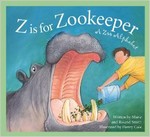Jon Muth is an author and illustrator whose work is so beautiful and powerful that I feel very humbled every time I get to experience one of his creations. Today's picture book title is the third of his Zen books, and once again Stillwater the panda bear features in the narrative.
Zen Socks
Zen Socks
Picture Book
Ages 6 and up
Scholastic, 2015, 978-0-545-16669-0
Leo and Molly love living in their
neighbourhood, and one of the reasons why they like living where they do is
because Stillwater lives across the road. Stillwater is a panda bear and he is
a gentle, kind, and wise friend.
One day Molly invites Stillwater to come outside to dance with her, and
soon she and the bear, both clad in tutus, are happily doing ballet on the
front lawn. Molly plans on becoming a ballet dancer like her aunt, and she will
get her dream by practicing all day. She tells Stillwater how she will become
famous and will “get flowers and lots of blue ribbons and tiaras and my name
will be on posters with lots of glitter!” Stillwater suggests that it might
take some time to attain this dream, but Molly is in a hurry to get the skill
and fame she seeks.
Stillwater
then tells Molly a story about a young fellow called Jiro who wants to become a
great swordsman like his father; so Jiro goes to see Banzo, the master
swordsman, to learn from him. Jiro is impatient and eager to learn as fast as
he can but instead of teaching him swordsmanship, Banzo makes Jiro work all day
doing chores. Only after three years have passed does Banzo start to teach Jiro
the skills he needs to have to wield a sword.
Molly understands what Stillwater’s story means. She needs to practice
diligently for “as long as it takes.” She must not rush a process that requires
both hard work and patience.
This lesson in patience is only one of many things that Molly and Leo
learn from Stillwater. Through his actions and his stories, Stillwater helps
the children understand that the root to happiness is not about getting “all
the best things for ourselves.” They also come to see that we must keep doing
the right and kind thing, even when it looks as if our actions seem inadequate
in a world full of problems.
In
this, his third, Zen book, Jon, J. Muth helps us see how little life
experiences can help us learn about the world and each other. Wisdom is there
for us to find if we just take the time to look around and open our eyes.


















